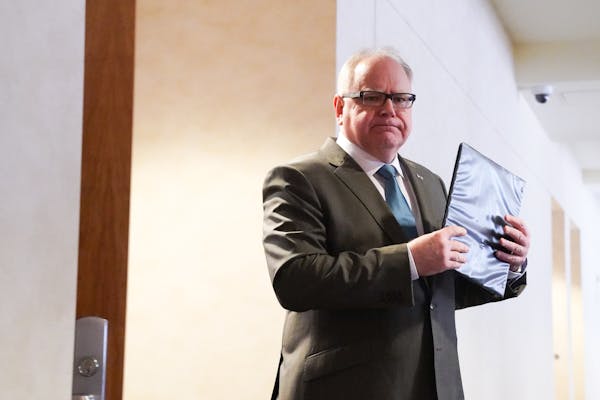The death toll from COVID-19 jumped from four to more than 20 in the first week of Gov. Tim Walz's stay-at-home order, but amid the loss and great public anxiety, there are signs of hope.
Declines in traffic and even crime mean that Minnesotans are taking social distancing obligations seriously, which bodes well because aggressive responses to the COVID-19 pandemic have been credited with at least leveling death tolls in hard-hit cities such as Seattle and San Francisco. And at least one national COVID-19 forecaster has reduced its death estimates for Minnesota based on the state's efforts.
"I think there's enough there that I certainly am confident that the decisions that we're making around social distancing are the right decisions," Walz said.
Modeling by the University of Minnesota and the Minnesota Department of Health showed that ordering people to stay at home would delay a surge of coronavirus infections that cause COVID-19, buying time for hospitals to add staff, beds and equipment — particularly ventilators for people who can't breathe due to their respiratory symptoms.
Minnesota has a history of compliance, based on a Federal Reserve paper analyzing the 1918 Spanish flu. Minneapolis shut down schools, churches and gathering places on Oct. 12, 1918, only six days after flu deaths started to spike, and kept its social distancing measures in place for 116 days. The city saw a lower-than-expected surge in deaths compared to others such as Philadelphia or even St. Paul, where a 35-day delay prompted a Nov. 3, 1918, St. Paul Pioneer Press editorial titled "In Heaven's Name Do Something!"
It's possible, though unstudied, that the Minnesota ethos lends itself to compliance, said Phyllis Moen, a U sociology professor.
"It does seem that 'Minnesota Nice' extends to staying 6 feet apart and to honoring directives that really matter," she said.
Minnesota even achieved an A- grade last weekend on the Unacast COVID-19 response scorecard, which uses mobile device data to assess mobility in states and counties. The tracking found mobility levels in Minnesota dropped by half, and that nonessential trips dropped more than 70%.
Car traffic levels have been 34% to 55% lower every day since March 28, when the stay-at-home order took effect, compared to the same dates in 2019, according to the Minnesota Department of Transportation. Use of Metro Transit local buses has decreased by more than 50%.
Even recent influenza data suggests progress, said Kris Ehresmann, state infectious disease director, because flu hospitalizations and positive tests plummeted last week.
"Social distancing has made a very big difference for that disease," she said.
The billion-dollar question is whether social distancing has made a difference against the coronavirus as well — literally so when considering that more than 320,000 Minnesotans have been put out of work amid the pandemic, with many filing for unemployment benefits that will exhaust the state's trust fund for that purpose.
When Walz issued the two-week stay-at-home order, the goal was an 80% reduction in face-to-face contact and viral transmission.
Modeling by the University of Washington's Institute for Health Metrics and Evaluation suggests this is working. Deaths so far haven't been increasing in Minnesota at the expected exponential rate, prompting the institute to lower its forecasted COVID-19 deaths in the state from around 2,000 two weeks ago to 932.
"We're seeing the impact of these measures and how early they are" put in place, said Ali Mokdad, chief strategy officer for population health at the University of Washington.
Walz said he will be looking this week for updated modeling from the Minnesota analysts — and any sign of infection or death numbers ebbing — before deciding whether to extend the stay-at-home order, which is scheduled to end April 10. The initial plan is to scale back to the lesser restrictions that had been in place for much of March — which would still include bar, dine-in restaurant and entertainment venue closures.
The state needs to use a science-based but "sustainable" strategy, Walz said, because public compliance with social distancing could wane.
"A lot of this depends on how well Minnesotans simply adhere to it without us telling them to — so that they're not jeopardizing the gains that we're making," Walz said.
Mobile device data has limits in terms of assessing social distancing compliance.
The Unacast ratings favor urban areas and give lower grades to rural areas, such as Minnesota's Pipestone County — which on March 31 received an F — where people travel farther for work and shopping. (Minnesota's grade dropped to a C- that weekday.)
Descartes Labs compensates in its analysis by looking at changes in median distances traveled by mobile device users. It found that Minnesotans on March 19 reduced the distance of their travels by 74%, and Pipestone residents cut their distances by 68%.
This distance-based measurement can be fooled, though, if people are taking multiple short trips.
"You could travel around and around in a circle, and it wouldn't count, since you don't get farther away from where you started," said Katie Anderson, a spokesperson for Descartes.
Even so, hospital leaders are hoping the indicators are true and that compliance with social distancing is at least delaying the surge in COVID-19 cases that is expected to consume all of their beds at some point.
Hospitals have made arrangements to add around 1,000 beds statewide in case of a surge — with Bethesda Hospital in St. Paul being converted entirely into a facility for COVID-19. State emergency management leaders have evaluated 14 sites as makeshift hospitals, if needed, for stable, non-COVID-19 patients.
Concern remains about adequate ventilators and stocks of personal protective equipment such as masks to protect caregivers so that they don't get sick as well, said Cheryl Petersen-Kroeber, director of emergency preparedness for the state Health Department. "If we lose that workforce, we're going to be in a bigger crisis."
A new state web page lists existing supply levels, including 374,000 N95 masks in stock and 1,600 awaiting delivery, and 208,000 gloves in stock and 660,000 awaiting delivery.
The state's access to more supplies is unclear, as Walz said it is competing against other states and the federal administration of President Donald Trump, whose recent use of the Defense Production Act has raised questions about whether some supplies of N95 masks from 3M in St. Paul will still be earmarked for local use.
Social distancing could make a crucial difference in allowing the state and its hospitals to stock up before any surge of COVID-19 cases, said Joe Kelly, state emergency management director.
"This goes back to the buying of time because that allows more time from order to delivery," he said.
Health officials have concerns about worried Minnesotans going too far. The recognition that people can spread this coronavirus before they have symptoms has led some to wear masks in public, but state health leaders have worried about the unintended consequences of that trend.
Masks could create false security for Minnesotans to forget social distancing and gather in crowds. And while there might not be as much harm wearing bandannas or hand-sewn masks, officials worry that people will decide to wear professional masks that health care workers need.
"They really do need to be homemade masks — certainly not the medical-grade masks that are in such short supply," said state Health Commissioner Jan Malcolm.
Another concern is a 60% decline in visits to M Health Fairview hospital emergency departments, even for urgent medical problems, due to infection fears.
One patient with a profusely bleeding arm and another with strokelike symptoms delayed coming to ERs for care they urgently needed, said Dr. David Milbrandt, an emergency department vice president at M Health Fairview.
"I get it," he said. "I'm scared as well, but our patients really need to know that, if they have a critical medical need, we're there for them."

This St. Paul native now goes by Kandi Krush, and she body-slams her opponents in the ring

Baseball Metro Player of the Year packs up his five tools and leaves

Prep baseball 2024: 35 Minnesota stars who the recruiters covet
Police searching for St. Paul home intruder who raped, robbed woman



